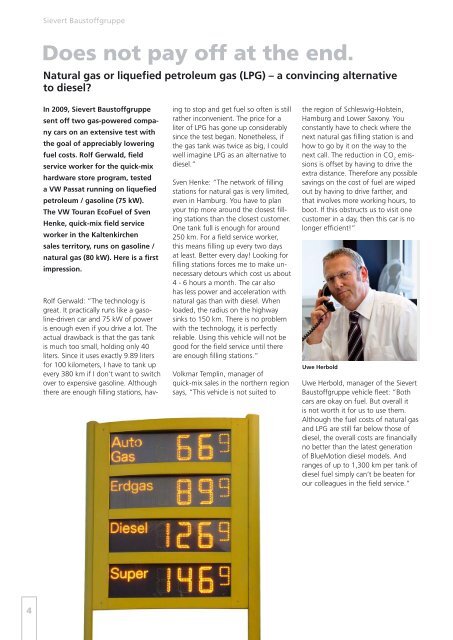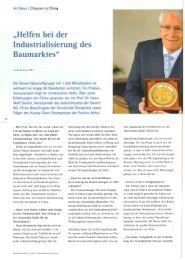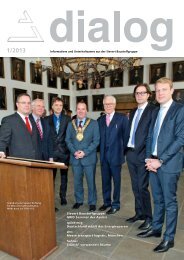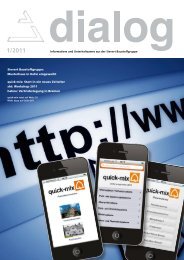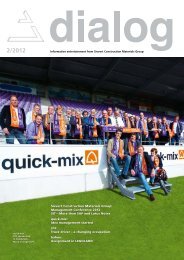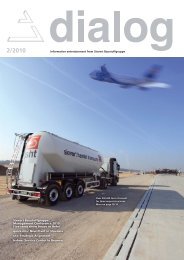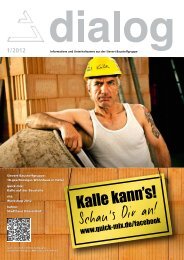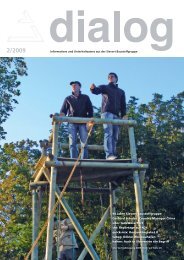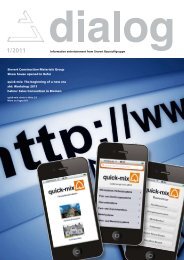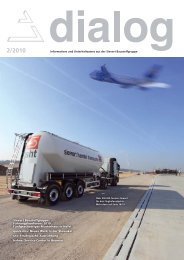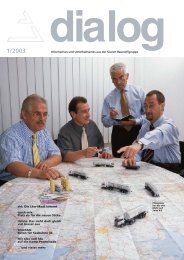1/2010 - Sievert AG
1/2010 - Sievert AG
1/2010 - Sievert AG
Create successful ePaper yourself
Turn your PDF publications into a flip-book with our unique Google optimized e-Paper software.
4<br />
<strong>Sievert</strong> Baustoffgruppe<br />
Does not pay off at the end.<br />
Natural gas or liquefied petroleum gas (LPG) – a convincing alternative<br />
to diesel?<br />
In 2009, <strong>Sievert</strong> Baustoffgruppe<br />
sent off two gas-powered company<br />
cars on an extensive test with<br />
the goal of appreciably lowering<br />
fuel costs. Rolf Gerwald, field<br />
service worker for the quick-mix<br />
hardware store program, tested<br />
a VW Passat running on liquefied<br />
petroleum / gasoline (75 kW).<br />
The VW Touran EcoFuel of Sven<br />
Henke, quick-mix field service<br />
worker in the Kaltenkirchen<br />
sales territory, runs on gasoline /<br />
natural gas (80 kW). Here is a first<br />
impression.<br />
Rolf Gerwald: “The technology is<br />
great. It practically runs like a gasoline-driven<br />
car and 75 kW of power<br />
is enough even if you drive a lot. The<br />
actual drawback is that the gas tank<br />
is much too small, holding only 40<br />
liters. Since it uses exactly 9.89 liters<br />
for 100 kilometers, I have to tank up<br />
every 380 km if I don’t want to switch<br />
over to expensive gasoline. Although<br />
there are enough filling stations, hav-<br />
ing to stop and get fuel so often is still<br />
rather inconvenient. The price for a<br />
liter of LPG has gone up considerably<br />
since the test began. Nonetheless, if<br />
the gas tank was twice as big, I could<br />
well imagine LPG as an alternative to<br />
diesel.”<br />
Sven Henke: “The network of filling<br />
stations for natural gas is very limited,<br />
even in Hamburg. You have to plan<br />
your trip more around the closest filling<br />
stations than the closest customer.<br />
One tank full is enough for around<br />
250 km. For a field service worker,<br />
this means filling up every two days<br />
at least. Better every day! Looking for<br />
filling stations forces me to make unnecessary<br />
detours which cost us about<br />
4 - 6 hours a month. The car also<br />
has less power and acceleration with<br />
natural gas than with diesel. When<br />
loaded, the radius on the highway<br />
sinks to 150 km. There is no problem<br />
with the technology, it is perfectly<br />
reliable. Using this vehicle will not be<br />
good for the field service until there<br />
are enough filling stations.”<br />
Volkmar Templin, manager of<br />
quick-mix sales in the northern region<br />
says, “This vehicle is not suited to<br />
the region of Schleswig-Holstein,<br />
Hamburg and Lower Saxony. You<br />
constantly have to check where the<br />
next natural gas filling station is and<br />
how to go by it on the way to the<br />
next call. The reduction in CO 2 emissions<br />
is offset by having to drive the<br />
extra distance. Therefore any possible<br />
savings on the cost of fuel are wiped<br />
out by having to drive farther, and<br />
that involves more working hours, to<br />
boot. If this obstructs us to visit one<br />
customer in a day, then this car is no<br />
longer efficient!”<br />
Uwe Herbold<br />
Uwe Herbold, manager of the <strong>Sievert</strong><br />
Baustoffgruppe vehicle fleet: “Both<br />
cars are okay on fuel. But overall it<br />
is not worth it for us to use them.<br />
Although the fuel costs of natural gas<br />
and LPG are still far below those of<br />
diesel, the overall costs are financially<br />
no better than the latest generation<br />
of BlueMotion diesel models. And<br />
ranges of up to 1,300 km per tank of<br />
diesel fuel simply can’t be beaten for<br />
our colleagues in the field service.”


